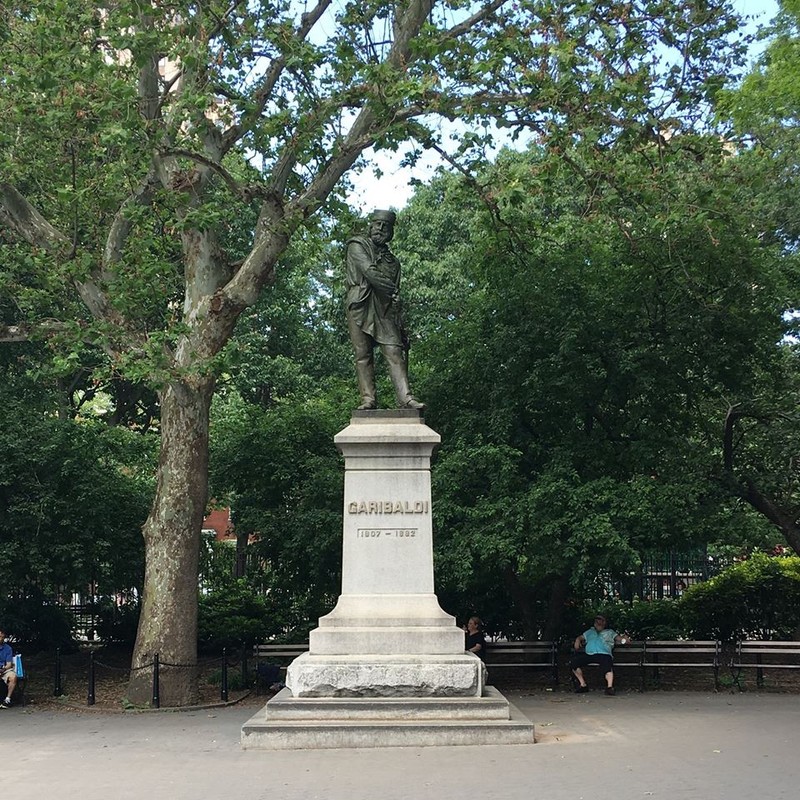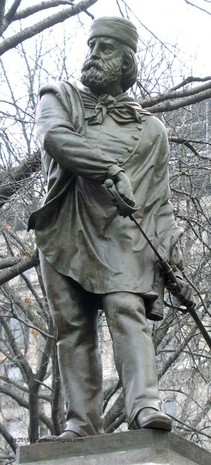Giuseppe Garibaldi Statue
Introduction
Text-to-speech Audio
Images
Giuseppe Garibaldi Statue

A closer look at the bronze statue

Giuseppe Garibaldi (1807-1882)
.jpg)
Backstory and Context
Text-to-speech Audio
Giuseppe Garibaldi was born in the Mediterranean coastal city of Nice in 1807. From a family of fishermen and coastal traders, he became a sailor, then a certified merchant captain, and finally a member of the navy of the Kingdom of Piedmont-Sardinia. In 1833, Garibaldi met Giuseppe Mazzini, an Italian nationalist, and joined his secret revolutionary society, Young Italy. The following year, Garibaldi participated in a mutiny meant to spark a republican revolution in Piedmont-Sardinia. When the conspiracy failed, he avoided arrest and execution by fleeing first to France and then across the Atlantic Ocean to Brazil.
Ultimately, Garibaldi spent twelve years in South America (1836-1848). It proved to be a formative period in his life and integral to his transformation into an international military hero. In the late 1830s, he served as a naval captain for the province of Rio Grande do Sul, which at the time was in revolt against the Brazilian government. While the province’s bid for independence was unsuccessful, Garibaldi began to garner fame throughout South America. Later, in the early 1840s, Garibaldi joined the Uruguayans in their struggle against Argentine dictator Juan Manuel de Rosas. While fighting against Argentine imperialism, he raised a volunteer legion of Italian exiles (known as the Redshirts) and gained invaluable experience in military leadership and guerilla warfare. Moreover, Garibaldi’s exploits during the war won him increasing fame throughout Europe, especially on the Italian peninsula.
In 1848, Garibaldi returned to Italy. The following year, he fought to defend the short-lived Roman Republic established by Mazzini and others. Garibaldi’s heroics in battle against French troops along with his daring escape from Austrian forces, however, helped to grow his fame. After the downfall of the Roman Republic, he went into exile once again, eventually taking up residence in New York City. In 1854, the prime minister of Piedmont-Sardinia, the Count of Cavour, permitted Garibaldi to return to Italy. He then took up residence on the island of Caprera, where he lived as a farmer for a few years.
Four years later, Piedmont-Sardinia was preparing for war with Austria. To this end, the Count of Cavour offered Garibaldi a commission as a major general in the Piedmontese army. After war broke out in early 1859, Garibaldi helped lead Piedmontese forces to victory. Defeated, Austria conceded Lombardy to France, which in turn gave it to Piedmont-Sardinia. Aside from Lombardy, Piedmont-Sardinia also annexed Tuscany, Modena, and Parma.
After the war with Austria, Garibaldi turned his attention southward. In 1860, he led a volunteer army of roughly 1,000 men to Sicily and then to Naples. After conquering both, he handed them over to Piedmont-Sardinia. The following year, a new national parliament proclaimed the Kingdom of Italy. In 1862 and 1867, Garibaldi led two unsuccessful offensives against Rome, which at the time was still under papal rule and protected by French troops. In 1866, he once again led troops to victory against Austrian forces, which allowed Italy to acquire Venice. In 1870, French forces withdrew from Rome to fight Prussia. After France’s defeat in the Franco-Prussian War, Italian troops entered the city and annexed the Papal States, completing the long process of Italian unification.
In the early 1870s, Garibaldi retired to his home on the island of Caprera. He spent his final years reading, writing, and farming. He died in 1882.
Shortly after Garibaldi’s death, members of New York City’s Italian-American community formed a committee to raise funds for the erection of a statue to commemorate the late Italian patriot. The committee hired Italian-born sculptor Giovanni Turini to design the statue. For Turini, the commission was not just an opportunity to earn money, but also a chance to honor his former commander. Turini, in fact, had volunteered to serve under Garibaldi during Italy’s war with Austria in 1866. Dedicated in Washington Square Park in 1888, Turini’s work, an over-life-sized bronze statue of Garibaldi, depicts the Italian hero in military garb attempting to draw his sword. It rests on a tall, elaborate granite pedestal. In 1970, the statue was moved a short distance from its original location to accommodate the construction of a promenade in the park. When workers relocated the statue, they discovered a time capsule containing items from the 1880s.
Sources
Bradford, James C., ed. International Encyclopedia of Military History. New York: Routledge, 2006.
"Giuseppe Garibaldi." Encyclopædia Britannica. Web. 22 January 2021 <https://www.britannica.com/biography/Giuseppe-Garibaldi>.
"Giuseppe Garibaldi." New York City Department of Parks and Recreation. The City of New York. Web. 22 January 2021 <https://www.nycgovparks.org/parks/washington-square-park/monuments/571>.
Hodge, Carl Cavanagh, ed. Encyclopedia of the Age of Imperialism, 1800-1914. Vol. 1, A-K. Westport, CT: Greenwood Press, 2008.
https://washingtonsquarehotel.com/who-is-garibaldi/
https://diannedurantewriter.com/giuseppe-garibaldi-washington-square
https://en.wikipedia.org/wiki/Giuseppe_Garibaldi
